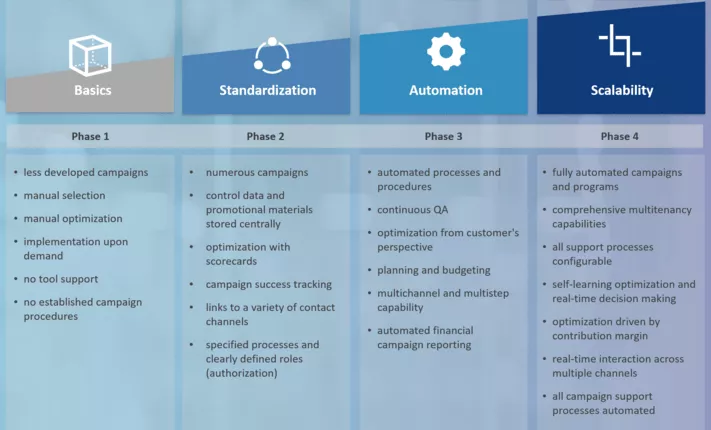The use of marketing clouds is growing rapidly – driven by changing customer needs and the desire for more effective and more efficient data-based dialog with customers. At the same time, marketing clouds are becoming increasingly complex. Consequently, many of those responsible for selecting and implementing a marketing cloud platform lack the experience to do so. This can cause a number of problems and ultimately lead to the failure of the project. This blog post in our series "Next Generation of CRM - May the MarTech be with you" sets out to highlight the potential hazards of using a marketing cloud and explains what steps you can take to avoid them.
"Move up to the cloud" is the call that the marketing community has recently chosen to heed. But the path to the cloud is not as straightforward as you might think. Which solution is the right one for my company? What features are important? What costs are we likely to incur? These are just a few of the questions that can bring beads of sweat to the brow of even the most experienced marketing managers. It's not hard to see why: selecting the wrong tool can quickly become a complex and expensive exercise.
Typical problems caused by choosing the wrong tool
- Campaign processes fail to speed up
Although the new tool should speed up campaign roll-out processes, they still take just as long or, even worse, longer than they did prior to implementation (e.g. messy data, complex segmentation processes, data transfer processes being ignored, ...) - More workflows - greater complexity
The implementation leads to greater workflow complexity (e.g. coordination and release processes, agreeing and creating content, preparing data for individual campaigns, etc.) - Lack of lessons learned
Regular modification and improvement plays a vital role in optimizing processes. It is not possible to optimize processes, however, when some of them are missing or are not properly integrated into existing processes (e.g. response data is analyzed but does not flow back as information – so nothing is learned about the response of customer groups). - You cannot run the campaigns you want to run
After implementation, you discover that the types of campaign you really want to run are not actually technically feasible – for example, an inadequate number of steps in multi-step campaigns; real-time, cross-channel rollout (via email, push, SMS) not possible, etc.). - Low user acceptance
The selection and implementation decision was taken by a small circle of people with no involvement of the employees who would later be working with the technology. Because their criticisms and recommendations were not heeded, their commitment is limited.
[Translate to English:]
Six factors for selecting and implementing marketing clouds successfully
No need to worry. These negative outcomes can be avoided – if you know the most important success factors. Based on our experience across numerous projects, we have compiled a list of the six most important factors for successfully selecting and implementing your marketing cloud.
1. Is your company really ready for a marketing cloud?
2. The modularity of marketing cloud solutions - what is needed and what is not?
Almost all of the marketing cloud solutions on the market are modular in structure. The tool's performance can be expanded and upgraded with the addition of modules (e.g. analytics, web tracking, push & in-app, etc.). However, additional modules not only cost money but they also increase complexity, have the potential to impair performance, and require specific employee skills and new processes.
It is therefore important to decide at the outset what functionalities you really need and whether you should look elsewhere for some of your requirements. If you decide to purchase modules, you should look very carefully at how well integrated they are and whether they are proprietary or third-party developments.
3. Channels and data flow – already integrated?
The decision to select and implement a marketing cloud solution is usually driven by a desire to plan, execute and measure cross-channel multi-step campaigns. Depending on which channels are used for this purpose, it should be clear beforehand whether these channels are connected out-of-the-box. As far as traditional CRM channels are concerned (email, SMS, letter), this is generally the case today, although it is not necessarily so with push/mobile, web/online or shop, where these channels may have to be integrated separately.
If the channel(s) are to function not just as outbound channels, there needs to be clarity from the outset about tracking (email, SMS, push, web, etc.), data import and export. How does the platform obtain its external data, how will the marketing cloud solution deliver contact history data (e.g. into the DWH) and how and where is the response data incorporated back into your systems (and made analyzable)? Well before the selection phase, the data architecture must be scrupulously planned on a number of levels, including system architecture, data structure and flow, analytics, and data storage.
4. Rights and roles in marketing clouds
The introduction of a marketing cloud can have a major impact on the company's organization and processes. Specific skills will be needed, traditional processes will change, new processes will emerge, and responsibilities will shift – and more. The full impact is rarely anticipated, and this can result in the failure of entire projects.
Here again, before selecting and implementing the solution, it is important to make sure that the company's organization and processes can cope with the future situation by, for example, establishing product ownership (functional, technical), defining users and the skills needed (do users need to be comfortable with IT to launch campaigns?), defining new campaign processes, (re-)defining responsibility for data, and so on. The necessary organizational and process restructuring may be sufficiently extensive to require the implementation of a change management process while the solution is being introduced.
5. Data strategy and data management
An essential step before initiating the selection and implementation process is to develop a clear data strategy and data management plan. This is because, when integrating a new solution into an existing system architecture, the issue of data reorganization inevitably raises its head: which data is needed, in which format and at what speed, how, when, in which systems, and for what purposes?
It is particularly important to be clear about the type of data, that is, what type of data is actually needed, where will it be generated, for what purposes will it be used, who will be technically responsible for the data? With this knowledge, you can develop a data strategy that will help you to select a marketing cloud solution capable of generating or processing the data you want.
You should also define how the data will be managed before selecting the tool. You need to know where the data will be centrally stored and the location of the central data logic; will it be in the data warehouse, the data mart or in the marketing cloud itself? How performant does the data storage have to be and what loading speeds and types (batch vs. real-time) are required? Which data must be made available to other systems from the marketing cloud, and at what speed? What are the advantages and disadvantages of individual working methods?
6. The optimum selection process. How to find the right provider!
In view of the number and complexity of marketing cloud solutions on the market, choosing the right tool is anything but trivial. A hasty and unprepared choice will not only result in the problems described earlier but will also be expensive and a drain on your resources. There is really no alternative to a carefully structured provider evaluation, even though this will often involve extensive research into potential providers, time-consuming organization of meetings with providers, and a considerable amount of time spent on coordinating the entire project.
6 + 1. Always on, thanks to mobile
Not a success factor yet, but it certainly has the potential to be one: mobile. It has certainly become one of the most important channels and should therefore also be selectable via the marketing cloud solution. Mobile - that is, push, in-app etc. is already integrated as a technical channel in most solutions. However, in order to use push notifications, the brand's SDK (software development kit) must be incorporated into the app.
Before selecting and implementing your tool, you not only have to know how and in what form you will be integrating the channel into your campaign planning, what data/KPIs you will be measuring and at what speed (near time, real time), but it must also be quite clear that using the channel will always require some degree of customization.
Even though it may not always look like it, selecting and implementing a marketing cloud solution is not trivial. The most common cause of dissatisfaction with implemented solutions is the lack of a clear strategic plan at the start of the process. Unless you are clear about your needs and requirements, the evaluation process is likely to result in the selection and implementation of an unsuitable tool. This is when those negative effects become apparent. These could not only have been avoided but – in a worst-case scenario – have the potential to threaten the viability of the entire project.
b.telligent has conducted many vendor evaluations over the years and has built up both the expertise and the broad network of technology partners needed to carry out an objective evaluation. We are familiar with the typical challenges that these projects face, the risks that can jeopardize success, and the factors that help to make evaluation and implementation projects effective, efficient and successful.
We can help you and your company plan an evaluation and help you find the right marketing cloud provider as well as to prepare a solid business case in support of your new marketing cloud. Just contact us and we will answer all your questions in a free, no-obligation initial meeting!












